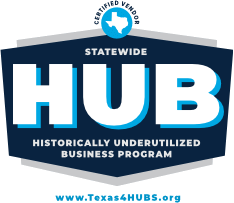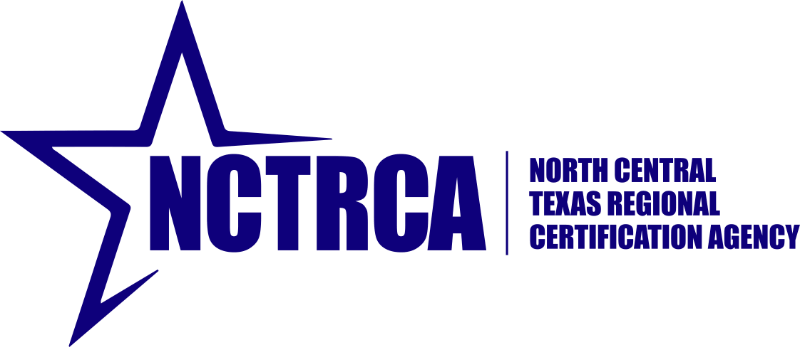Managing hybrid and remote teams presents a unique set of challenges for IT leaders like CTOs and CIOs. The shift to flexible work environments requires more than just managing from a distance—it demands new leadership skills to maintain communication, trust, and performance across dispersed teams.
This article explores how improving leadership skills for managing hybrid and remote teams can help leaders overcome these challenges. We’ll dive into the importance of effective communication, fostering trust, promoting inclusivity, preventing burnout, and how executive coaching can empower leaders to excel in today’s evolving workplace. By mastering these skills, IT leaders can lead their teams more effectively, boosting productivity and engagement in a hybrid world.
TL;DR: Managing hybrid and remote teams requires a new set of leadership skills that focus on communication, trust, inclusivity, and preventing burnout. This article covers essential strategies for building effective communication channels, fostering trust in remote settings, and empowering your team. It also explores how executive coaching can help IT leaders navigate the complexities of leading hybrid teams, ensuring they can maintain high performance and engagement across both in-office and remote workers.
The Evolution of Leadership in the Digital Age
The shift to hybrid and remote work has fundamentally changed the way leaders interact with their teams. Traditional face-to-face management techniques are no longer enough to foster connection, build trust, or ensure productivity in a dispersed environment. IT leaders, particularly CTOs and CIOs, now face the challenge of maintaining cohesion and performance while team members work in varying locations, often across time zones.
In the digital age, communication, inclusivity, and adaptability have emerged as the cornerstones of effective leadership. Research suggests that leaders who excel at managing hybrid teams focus on outcomes rather than processes, emphasizing performance over presenteeism. This shift encourages greater autonomy among remote workers, fostering a sense of ownership over their tasks (as noted by McKinsey).
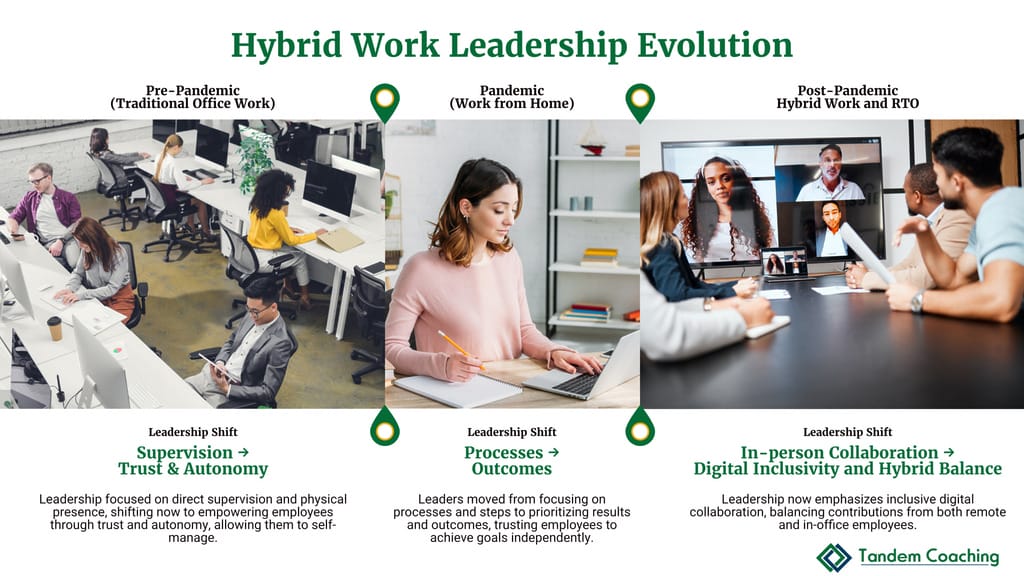
The need for this evolution is evident: A study by McKinsey & Company revealed that only 10% of executives now expect their employees to work primarily in the office post-pandemic, compared to 99% before 2020 (McKinsey). This drastic change underscores the importance of developing new leadership skills tailored to the hybrid work model.
“Leaders must now become facilitators, enabling collaboration through technology and ensuring every team member feels heard and valued, regardless of where they are.”
As we move further into the digital era, the role of executive coaching in refining these leadership skills cannot be overstated. Coaching helps leaders identify their blind spots and provides personalized strategies for managing hybrid teams effectively.
Building Strong Communication Skills
Effective communication is the foundation of successful hybrid and remote team management. When teams are spread across different locations, ensuring that information flows smoothly is crucial to maintaining both productivity and morale. In hybrid environments, it’s easy for remote employees to feel disconnected, especially when spontaneous in-person interactions are happening in the office.Balancing synchronous (real-time video calls) and asynchronous (email, messaging) communication is key. Leaders need to master both methods to ensure that all team members, regardless of location, feel informed and included. Synchronous communication is essential for immediate feedback and collaboration on complex tasks, while asynchronous methods provide flexibility and respect for varying schedules. According to a study by McKinsey, successful hybrid leaders focus on deliberate and transparent communication to ensure inclusivity in team dynamics (McKinsey).For example, Microsoft CEO Satya Nadella emphasizes the importance of empathy and communication in a remote work environment, regularly holding town hall meetings to engage both in-office and remote workers. This practice helps unify the team while addressing the challenges of hybrid communication (Harvard Business Review).“Leaders must develop a communication rhythm that accommodates the needs of both in-office and remote employees, ensuring inclusivity in critical conversations.”By strategically using both synchronous and asynchronous communication methods, leaders can prevent feelings of isolation among remote employees and keep the team aligned.
Fostering Trust and Autonomy
As hybrid work solidifies its place in modern business, fostering trust has become a pivotal responsibility for leaders. Yet, many companies have been pushing for Return to Office (RTO) initiatives, aiming to regain a sense of control. This trend, however, has often resulted in reduced morale, as employees feel their autonomy slipping away. When leaders equate physical presence with productivity, they overlook the benefits of an outcome-driven approach and risk undermining the very trust they need to build within their teams.The illusion of control is one of the primary reasons for these RTO pushes. Leaders who grew accustomed to managing through proximity mistakenly believe that seeing their employees in the office equates to engagement or performance. This miscalculation has been demoralizing for many employees who, during the pandemic, thrived in remote settings by balancing work and life more effectively. According to McKinsey, 29% of employees have considered leaving their jobs if forced back into the office full-time (McKinsey).Building trust in a hybrid setting doesn’t come from proximity—it stems from leaders focusing on outcomes rather than processes. IBM, under the leadership of Arvind Krishna, exemplifies this mindset by fostering an environment where employees are evaluated on their results, not their location (Harvard Business Review).“By trusting their teams to work independently, leaders can unlock greater creativity, innovation, and engagement across the organization.”Leaders need to understand that autonomy empowers employees to perform better. Hybrid and remote employees often show increased productivity because they feel trusted. When RTO policies threaten this autonomy, they undermine morale and the trust that remote work has built over time.Additionally, fostering trust involves setting clear goals, regularly providing feedback, and ensuring team members have the resources they need to succeed. These steps help employees feel supported rather than micromanaged, promoting a healthier and more engaged work culture.
Leading with Empathy and Emotional Intelligence
Empathy is no longer a “soft skill”—it’s a critical leadership trait, especially in hybrid and remote work environments. Leaders who can understand their team members’ perspectives and challenges are better equipped to foster engagement and productivity. In a hybrid setting, this emotional intelligence (EI) becomes even more essential, as leaders must bridge the gap between remote and in-office employees. Empathy drives trust, helps resolve conflicts, and ensures everyone feels valued.
In hybrid work, the lack of face-to-face interaction can lead to misunderstandings and disconnects. It’s easy for remote employees to feel left out of the conversation or for office-based employees to unintentionally dominate discussions. Leaders must actively listen, be mindful of these dynamics, and make a concerted effort to involve everyone in key decisions. Eric Yuan, CEO of Zoom, emphasizes the importance of fostering empathy and open communication in a virtual setting to create cohesion and ensure that all voices are heard (Harvard Business Review).
The empathy factor is especially important when addressing the burnout increasingly seen among remote workers. Flexible hours have blurred the lines between personal and professional life, leading to overwork and stress. Empathetic leaders not only recognize these challenges but also take proactive measures to support their team’s well-being. For example, Salesforce CEO Marc Benioff has been vocal about creating a culture of empathy, where leaders prioritize employee mental health and work-life balance, offering flexibility and support to prevent burnout (McKinsey).
“Empathy is not about solving every problem—it’s about acknowledging the challenges your team faces and making them feel supported.”
In practice, leading with emotional intelligence means going beyond surface-level interactions. It involves deeper conversations, understanding individual circumstances, and being adaptable in how you respond to various team members’ needs. Leaders who actively demonstrate empathy build stronger, more cohesive teams that can navigate the challenges of hybrid work more effectively.
Creating an Inclusive Hybrid Team Culture
Creating an inclusive culture within a hybrid team is essential for ensuring that every employee feels valued, whether they’re in the office or working remotely. One common issue that arises is proximity bias, where in-office employees receive more visibility and attention, leaving remote workers feeling marginalized. Leaders must actively combat this bias by being deliberate about involving all team members in key conversations and decision-making processes.Inclusivity requires setting clear norms and expectations that apply to everyone, regardless of location. According to research from Harvard Business Review, leaders should promote equity by ensuring that hybrid meetings and team collaborations are structured to include input from both remote and in-office employees (Harvard Business Review).Practical steps to enhance inclusivity include:- Rotating meeting leadership: Allow different team members to lead meetings, whether they’re remote or in the office, which ensures that everyone has a chance to contribute and be seen as a leader.
- Using technology to bridge gaps: Tools like Slack, Zoom, or Microsoft Teams can help break down communication barriers. Leaders should be mindful of creating an environment where remote employees feel just as connected and informed as their in-office counterparts.
“A culture of inclusion doesn’t happen by chance—it’s built through intentional actions that promote equity and engagement across the entire team.”By consciously prioritizing inclusion, leaders can create a hybrid work environment where everyone feels empowered to contribute, regardless of where they are working.
Managing Performance and Outcomes
In a hybrid work environment, leaders must shift their focus from managing day-to-day tasks to evaluating outcomes. The traditional approach of monitoring how employees spend their time doesn’t translate well in hybrid settings, where flexible schedules are common. Instead, leaders should prioritize results-driven management, which empowers employees to take ownership of their work and drives better performance.
A critical part of this approach involves setting clear, measurable goals. Leaders should communicate expectations early and regularly review progress to ensure everyone stays aligned. For instance, Microsoft CEO Satya Nadella introduced outcome-based evaluations, which have been instrumental in navigating the complexities of hybrid work (Harvard Business Review).
Here are some strategies to enhance performance management in hybrid teams:
- SMART goals: Ensure objectives are Specific, Measurable, Achievable, Relevant, and Time-bound.
- Regular check-ins: Conduct weekly or bi-weekly check-ins to assess progress and provide feedback.
- Utilize performance metrics: Use key performance indicators (KPIs) tailored to both team and individual objectives.
“In a hybrid setting, it’s not about how many hours someone spends at their desk—it’s about the value they deliver.”
Leaders who focus on outcomes, rather than how work gets done, foster a culture of accountability and trust. By clearly defining success metrics and removing barriers to achievement, leaders can help hybrid teams excel.
Leveraging Technology to Enhance Collaboration
In a hybrid work environment, technology is the linchpin that keeps teams connected and productive. The right tools not only streamline communication but also foster collaboration across geographically dispersed team members. However, technology is only as effective as the processes and engagement behind it. Leaders must ensure that both in-office and remote employees have access to, and are proficient with, collaboration technologies that meet the specific needs of hybrid teams.
Key tools like Zoom, Slack, and Microsoft Teams have become indispensable for hybrid collaboration, providing real-time communication channels. As Eric Yuan, CEO of Zoom, pointed out, continuous innovation in virtual meetings is critical to maintaining cohesion in hybrid teams (Harvard Business Review).
Here are five strategies for effectively leveraging technology in hybrid environments:
- Adopt user-friendly platforms: It’s essential to select collaboration tools that are intuitive and accessible for every team member, reducing friction in adoption.
- Integrate project management systems: Tools like Asana, Trello, and Monday.com help manage workloads, track progress, and ensure team accountability.
- Use cloud-based collaboration: Platforms like Google Workspace and Microsoft 365 enable real-time editing and sharing, keeping the team in sync, regardless of location.
- Provide comprehensive training: Don’t assume familiarity with tools. Regular training ensures employees use technology efficiently, enhancing overall productivity.
- Create clear guidelines: Define how and when each tool should be used to avoid fragmentation and ensure streamlined communication across the team.
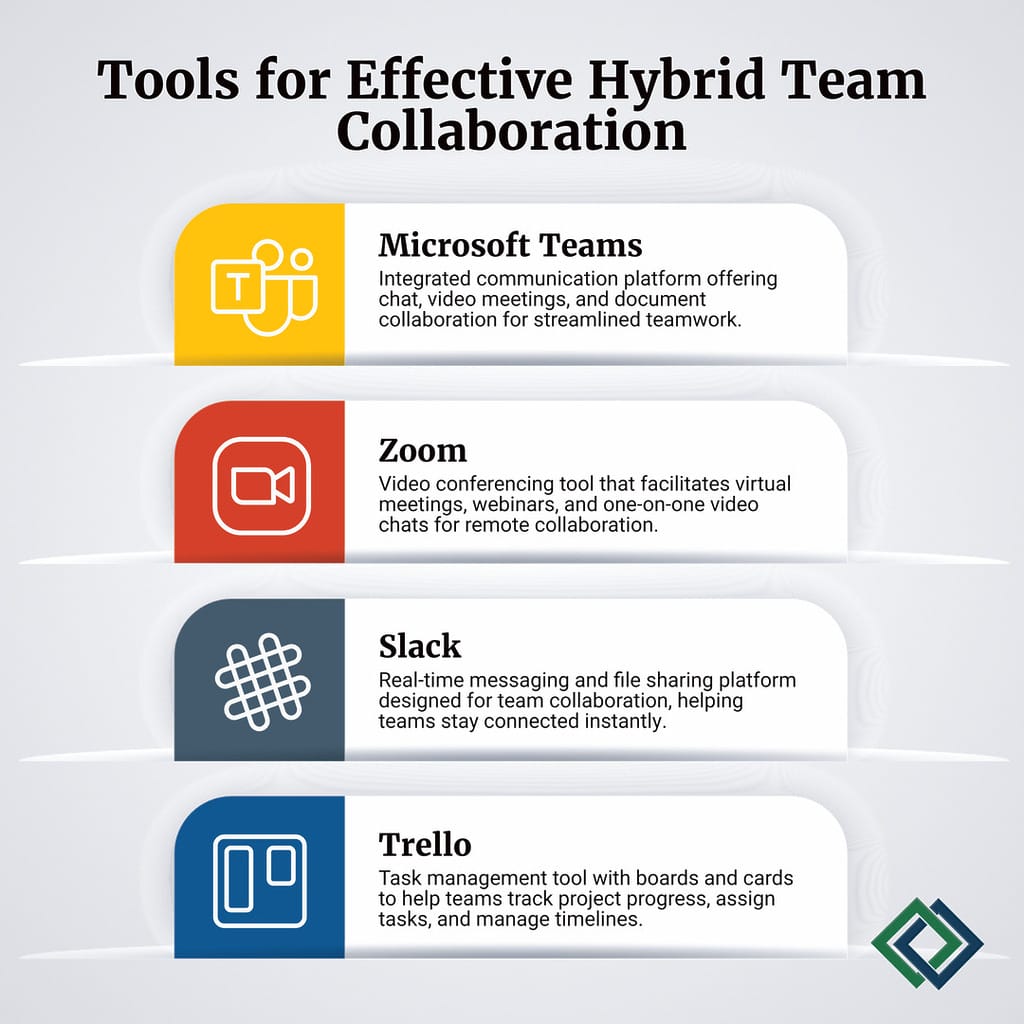
While technology can bridge the gap between remote and in-office employees, the real power lies in how leaders implement and manage these tools. Leaders should focus on creating a cohesive digital workspace where technology enhances workflows, rather than complicates them. This means establishing norms for communication, sharing clear protocols for task management, and encouraging a culture where the use of collaborative tools is not just required but appreciated.
Furthermore, leaders must remain adaptable, regularly reviewing the tools and processes in place to ensure they still meet the team’s evolving needs. Technology is not a one-size-fits-all solution, and hybrid teams require ongoing adjustments to optimize their collaborative efforts. It’s not just about having tools at your disposal but about fostering a collaborative mindset that drives engagement and innovation.
Maintaining Team Well-being and Preventing Burnout
In hybrid and remote work settings, employee well-being is more vulnerable than ever. The blurred boundaries between home and work life, combined with the pressures of constant connectivity, have made burnout a significant risk. Leaders must proactively address this by fostering an environment where mental health is prioritized and work-life balance is respected.
One of the key challenges is that employees working remotely often feel the need to overcompensate, putting in longer hours and staying “online” beyond regular work times. This can lead to chronic stress and burnout, ultimately impacting productivity and team morale. According to research, isolation and burnout are two of the top concerns for remote employees, with many citing a lack of clear boundaries between work and personal time (McKinsey).
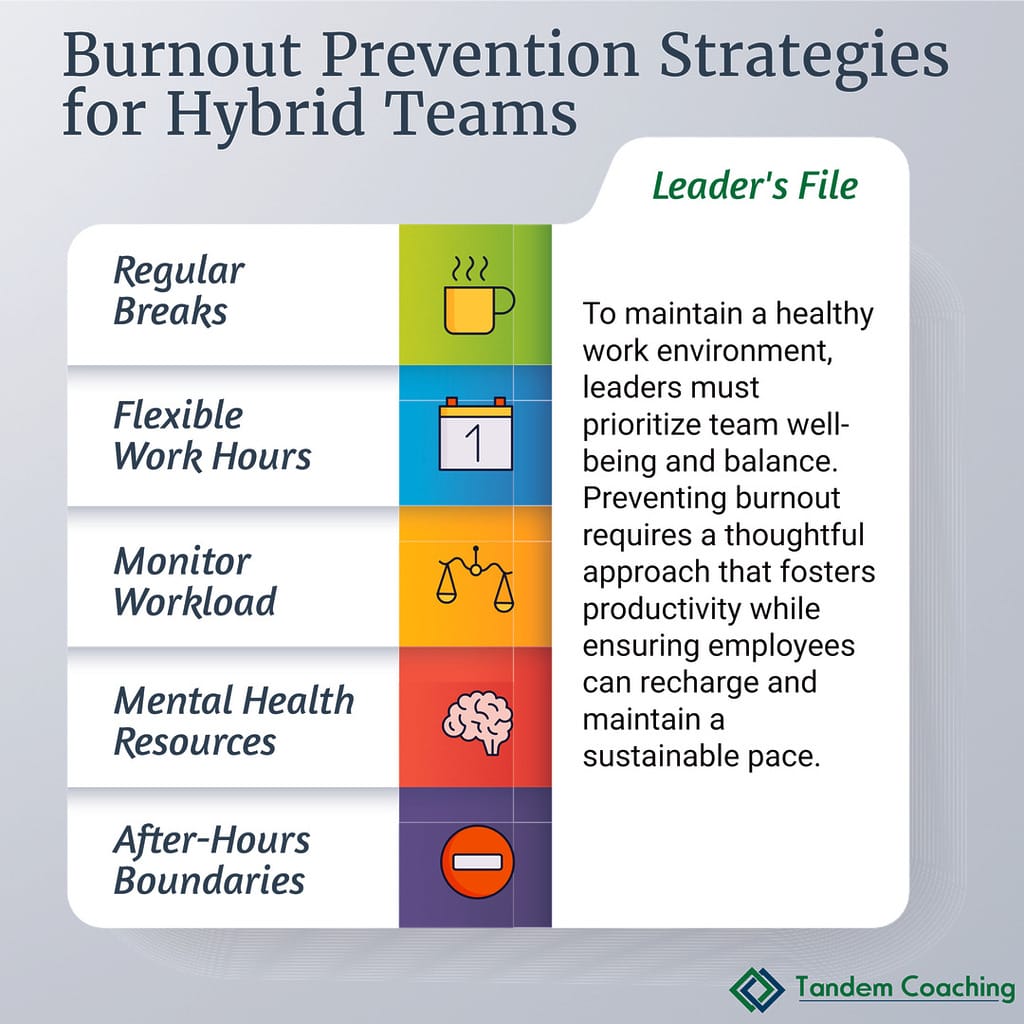
To prevent burnout, here are some essential strategies that leaders can implement:
- Encourage regular breaks: Make it clear that employees are not expected to be constantly available and should take breaks to recharge during the day.
- Promote flexible work hours: Allow team members to manage their own schedules, giving them the flexibility to balance personal and professional responsibilities.
- Monitor workloads: Keep an eye on team members’ workloads to ensure no one is overwhelmed. Offer support when necessary.
- Offer mental health resources: Provide access to counseling services or mental health days to help employees manage stress.
- Set boundaries for after-hours communication: Establish clear policies that discourage late-night emails or work-related messages, creating a distinction between work and personal time.
“Leaders must lead by example—by prioritizing their own well-being and setting boundaries, they give permission for their teams to do the same.”
It’s critical for leaders to regularly check in with their teams, not just about work progress, but also about well-being. A simple gesture, like encouraging employees to take time off or unplug during weekends, can go a long way toward preventing burnout.
Building a culture of support is vital in any hybrid work model. When employees feel seen, heard, and cared for, they are more likely to perform at their best, resulting in greater long-term success for both the individual and the organization.
Developing Leadership Agility and Flexibility
In today’s rapidly evolving hybrid work environment, agility and flexibility have become critical leadership skills. The pace of change is faster than ever, and leaders must be prepared to pivot quickly in response to new challenges, whether it’s adapting to technological shifts, market changes, or unexpected disruptions like a global pandemic. Leadership agility means not just reacting to change but anticipating it and staying ahead of the curve.Agile leaders are adept at iterative decision-making, learning from short-term outcomes and making necessary adjustments. This approach allows for quick course corrections, helping teams stay aligned with organizational goals even as circumstances evolve. According to McKinsey, organizations that embrace flexibility in their leadership see improved resilience and innovation (McKinsey).Here are key strategies to enhance leadership agility:- Encourage continuous learning: Leaders must stay updated on new trends, technologies, and best practices, ensuring their skills evolve along with the business landscape.
- Foster adaptability in teams: Create a culture where change is seen as an opportunity rather than a disruption. This involves promoting a growth mindset across the organization.
- Delegate effectively: Trust team members to take ownership of decisions in their areas of expertise. This decentralizes control and increases the team’s ability to respond swiftly.
- Be open to feedback: Leaders who actively seek input from their teams are better equipped to understand potential issues and act on them quickly.
- Prioritize resilience: Focus on building both personal and organizational resilience, ensuring the team can bounce back from setbacks.
“The most effective leaders today are those who are comfortable with ambiguity, and who see uncertainty as an opportunity for innovation and growth.”By fostering a leadership style that embraces flexibility, IT leaders can navigate the complexities of hybrid work with confidence. The ability to adapt and respond quickly to change is what differentiates successful leaders in this dynamic environment.
Cultivating a Collaborative Problem-Solving Culture
Collaboration is at the heart of any successful hybrid or remote team, but fostering true collaboration in a dispersed workforce requires deliberate effort. When teams are split between the office and home, it’s easy for communication breakdowns or misunderstandings to arise. Leaders must actively promote an environment where problem-solving becomes a shared, collective effort.Hybrid teams thrive when leaders create a culture where every voice is valued. This involves setting clear expectations around collaboration, ensuring that remote team members are just as involved in brainstorming and decision-making processes as their in-office peers. The traditional hierarchical approach to solving problems simply doesn’t work in hybrid settings—what works best is cross-functional collaboration, where team members from various roles and locations come together to offer solutions.One real-world example comes from Salesforce, where leadership prioritizes inclusivity in decision-making by fostering open discussions across all team members, regardless of their work location. This approach has not only boosted innovation but has also helped maintain a strong sense of unity across hybrid teams (McKinsey).Collaboration can also be enhanced by making problem-solving an ongoing process rather than a reactionary task. Leaders should encourage continuous feedback and brainstorming sessions, where both challenges and ideas are shared openly. In doing so, teams become more agile and better equipped to handle unexpected issues.“Collaboration isn’t just about working together—it’s about bringing diverse perspectives to the table and leveraging them to solve problems creatively.”When leaders cultivate this mindset, teams become more resilient, adaptable, and innovative—key traits needed to succeed in the ever-changing landscape of hybrid work.
Conclusion
Managing hybrid and remote teams presents both challenges and opportunities for today’s IT leaders. As the workplace continues to evolve, the need for adaptable, empathetic, and outcome-focused leadership has never been greater. Leaders who prioritize communication, trust, inclusivity, and collaboration are better equipped to navigate this landscape, ensuring that their teams remain engaged and productive regardless of their work location.Fostering trust through autonomy, leveraging technology effectively, and addressing employee well-being are essential components of leading a successful hybrid team. Leadership in this environment isn’t just about managing tasks—it’s about driving results through empowered, connected, and resilient teams.“Leadership is evolving, and those who adapt will not only succeed in hybrid work but will thrive in fostering innovation and engagement.”In this new world of work, executive coaching offers tailored guidance that helps leaders strengthen their skills and adapt to the demands of managing hybrid and remote teams. By investing in their development, leaders can inspire their teams to achieve their highest potential.If you’re looking to sharpen your leadership skills for managing hybrid teams, consider the benefits of executive coaching. At Tandem Coaching, our tailored coaching solutions can help you build trust, improve communication, and lead your team with confidence—whether they’re in the office or working remotely.Are you ready to take your leadership to the next level? Explore our executive coaching services and start transforming your hybrid leadership approach today.
Final Thoughts: Leadership Insights for Hybrid Success
Prioritize Communication: Effective leaders balance synchronous and asynchronous communication to keep hybrid teams connected and informed.
Build Trust Through Autonomy: Focus on outcomes, not processes, and give employees the freedom to take ownership of their work.
Empathy Matters: Leading with empathy and emotional intelligence boosts team engagement and well-being.
Leverage Technology: Use collaboration tools like Slack, Zoom, and Trello to foster seamless communication.
Prevent Burnout: Set clear work boundaries, promote mental health, and encourage work-life balance in hybrid teams.
FAQs: Leadership for Hybrid and Remote Teams
How can I build trust with a remote team?
Building trust with a remote team requires focusing on outcomes rather than processes, ensuring transparency, and providing autonomy. Regular check-ins, setting clear expectations, and recognizing achievements are essential. Offering flexibility and maintaining open communication channels also strengthen trust. Leaders like those at IBM focus on results-driven management to build trust across hybrid teams.
What are the best tools for hybrid team collaboration?
Essential tools for hybrid teams include Slack for messaging, Zoom for video calls, and Trello or Asana for task management. These platforms help streamline communication and collaboration. Using cloud-based solutions like Google Workspace ensures that teams can work on documents in real-time, regardless of location. More on effective tool use can be found in Microsoft’s approach.
How can leaders prevent burnout in hybrid teams?
Preventing burnout involves promoting work-life balance, encouraging regular breaks, monitoring workloads, and setting boundaries around after-hours communication. Providing mental health resources and encouraging employees to set their own schedules also reduces stress. These strategies are particularly important in hybrid settings where employees may struggle to disconnect.
What are the key leadership skills for managing hybrid teams?
Effective leadership in hybrid teams requires strong communication, empathy, and emotional intelligence. Leaders must be adaptable, outcome-focused, and proactive in fostering inclusivity. Empathy is critical for understanding remote employees’ challenges, while strong communication ensures everyone stays informed and engaged.
How can I manage performance in a hybrid team?
Performance management in hybrid teams should focus on outcome-based evaluations rather than monitoring hours. Set clear goals and KPIs, provide regular feedback, and conduct check-ins to assess progress. Leaders like Satya Nadella at Microsoft emphasize the importance of results-driven performance to ensure that hybrid teams remain productive.
How do you maintain inclusivity in hybrid teams?
To create an inclusive hybrid team culture, leaders must actively engage remote employees in decision-making processes and ensure they have equal access to resources. Hosting meetings where both in-office and remote employees can contribute, and rotating meeting leadership helps to combat proximity bias. Promoting inclusivity ensures everyone feels valued, which is vital for maintaining high morale.
Why is flexibility important for hybrid team leadership?
Flexibility allows leaders to adapt to the changing needs of their team, especially in hybrid work environments where schedules and workflows vary. Leaders who can pivot quickly are better equipped to handle challenges and foster innovation. Flexibility also helps leaders build trust, as employees appreciate having control over their schedules and tasks.
What are common challenges in managing hybrid teams, and how can they be overcome?
Challenges include communication breakdowns, proximity bias, and disengagement. These can be overcome by using both synchronous and asynchronous communication methods, prioritizing inclusivity, and fostering a collaborative culture. Leaders should also use technology effectively to keep teams aligned and connected.


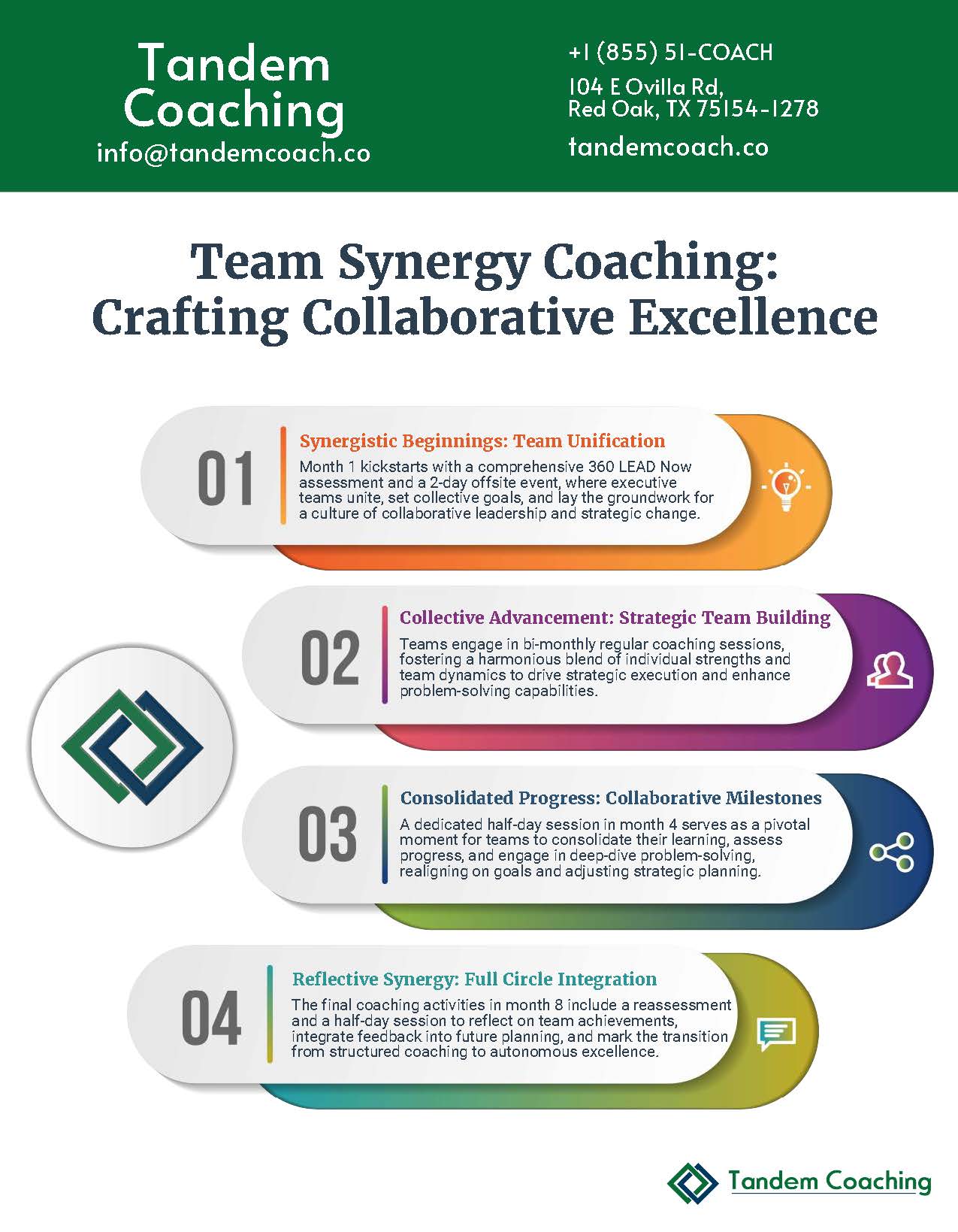
Boost Your Leadership Team Success!
Take your leadership team to the next level and achieve great results with our executive coaching.
Learn how our coaching and ASPIRE method can change things for you—get a free brochure to begin your journey.
About the Author
Cherie Silas, MCC
She has over 20 years of experience as a corporate leader and uses that background to partner with business executives and their leadership teams to identify and solve their most challenging people, process, and business problems in measurable ways.













